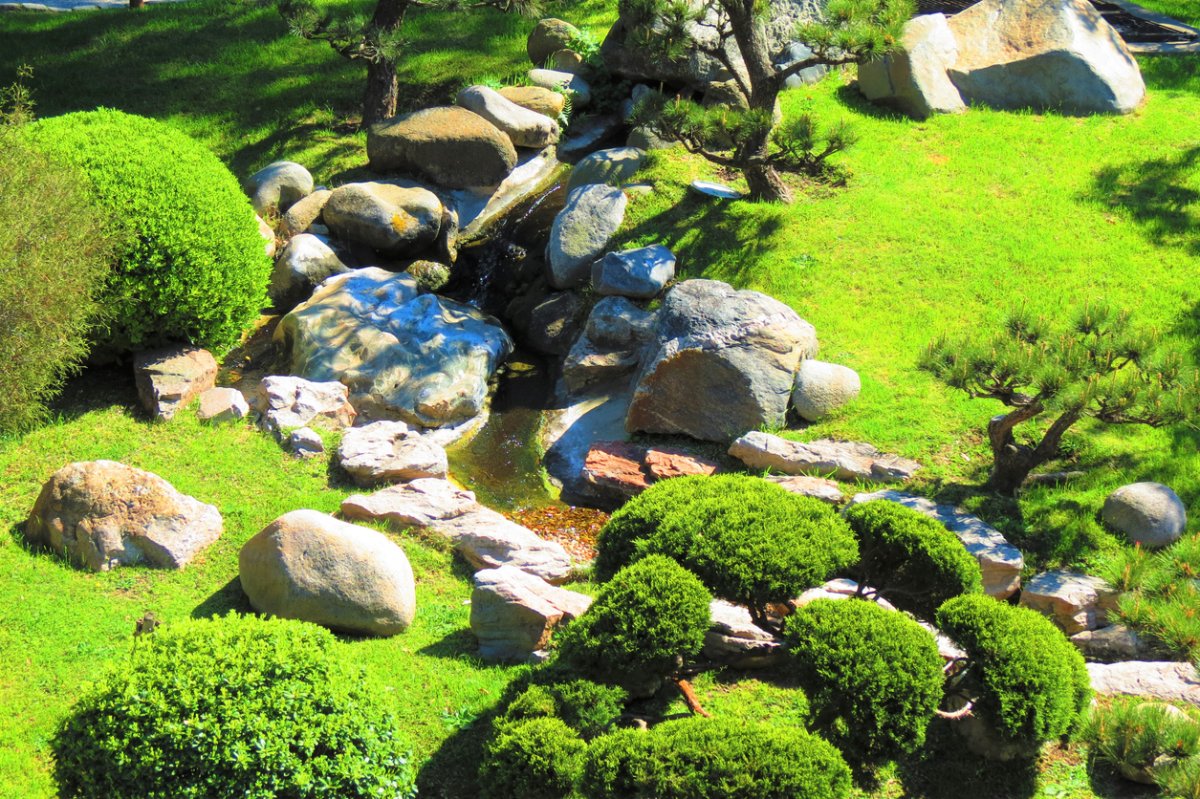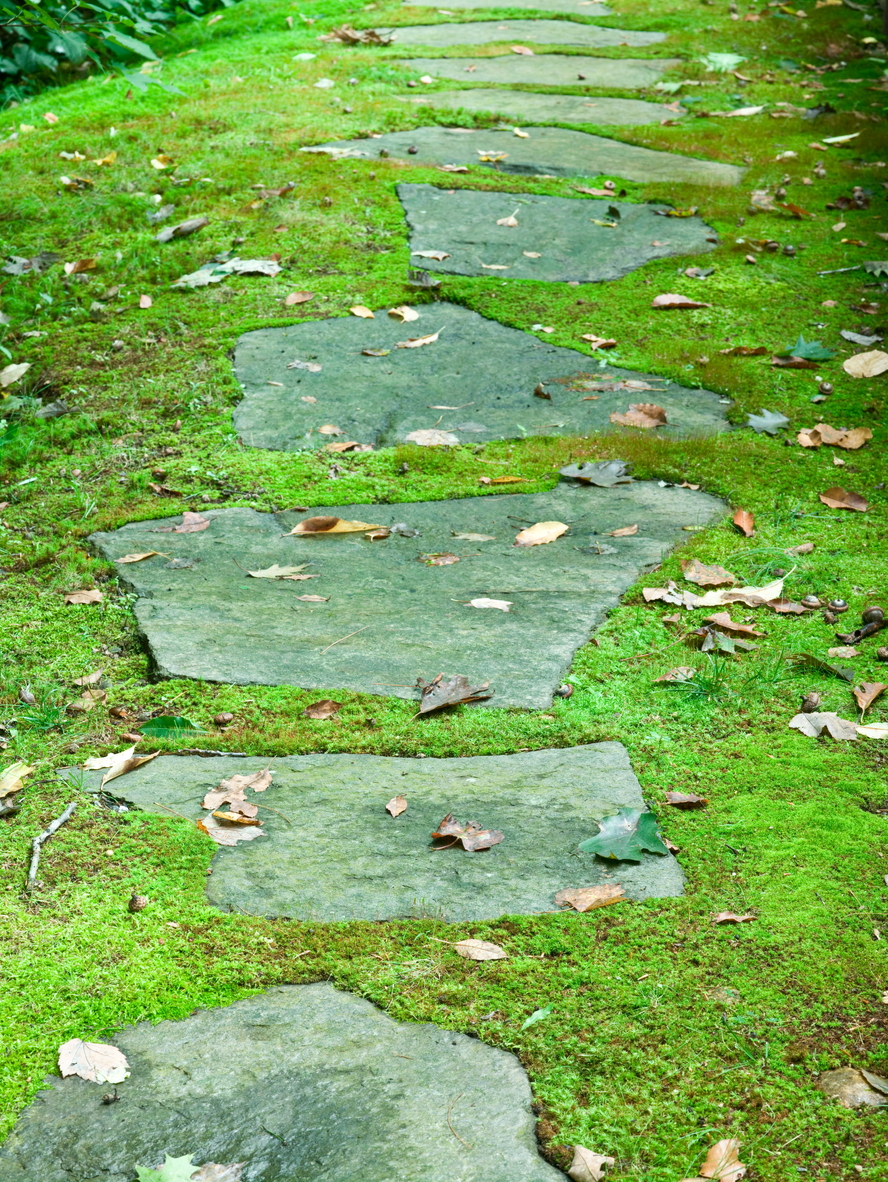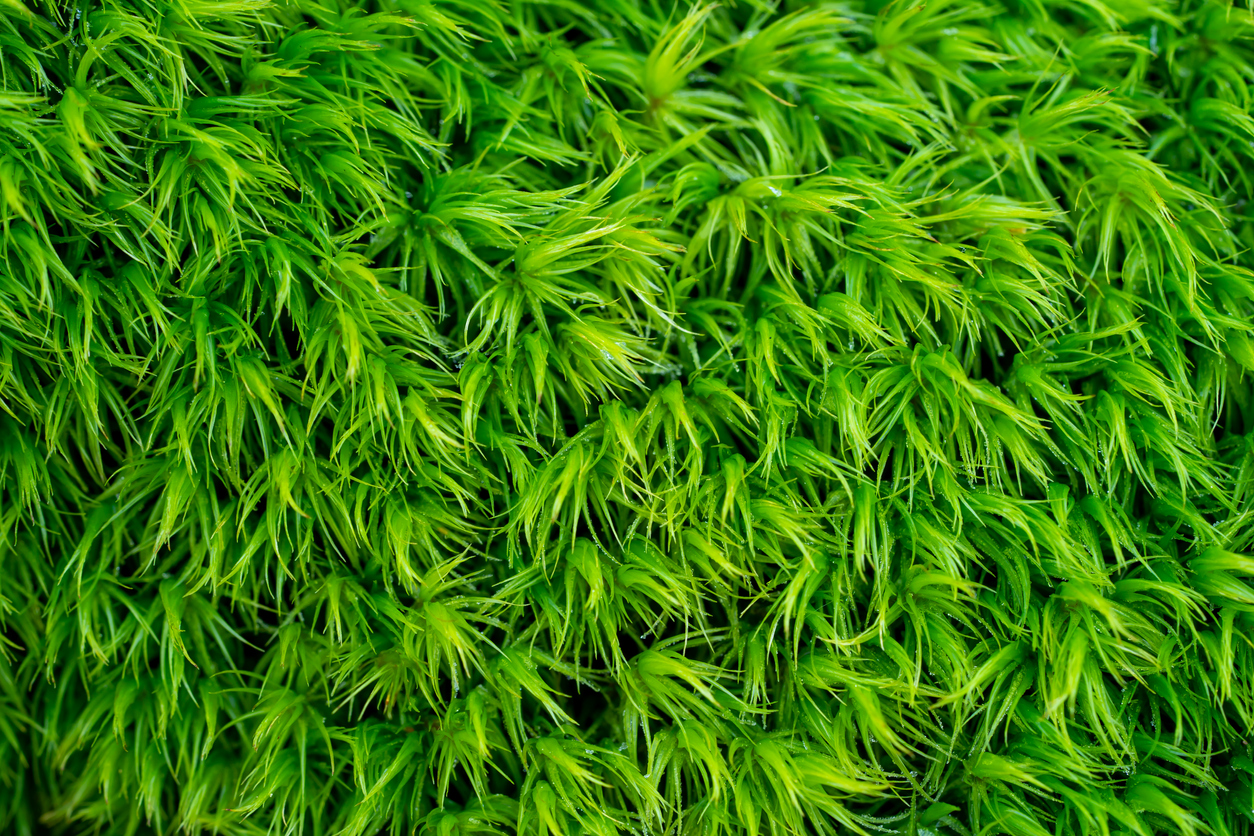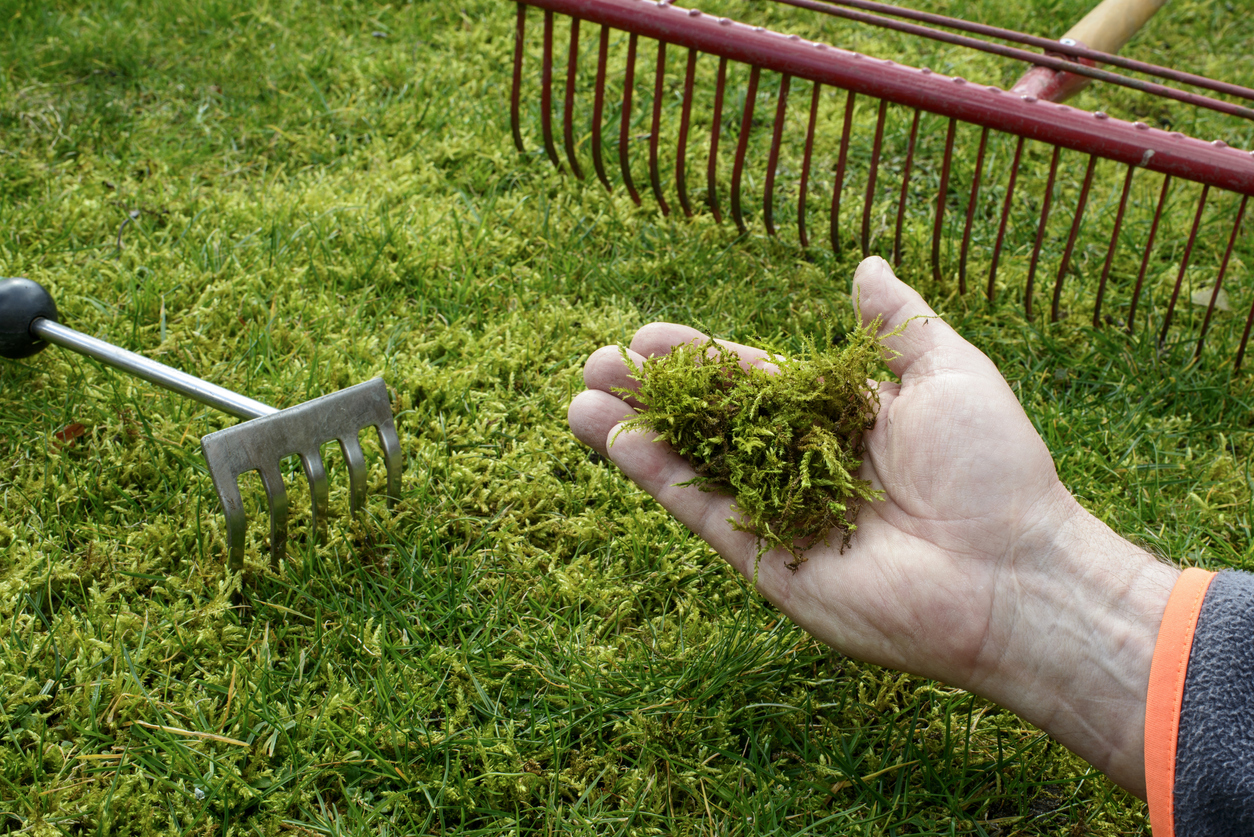

We may earn revenue from the products available on this page and participate in affiliate programs. Learn More ›
Tired of mowing the grass week after week? Perhaps it’s time to consider a moss lawn. Common in Japanese gardens, moss lawns are a low-maintenance alternative if conditions are right. Swapping turfgrass for moss as a lawn has many benefits beyond eliminating mowing, particularly if your lawn has poor soil, rocky conditions, or a steep slope.
Moss lawn care is minimal. A moss garden will require lots of shade and plenty of rainfall, but is otherwise relatively easy to maintain in most USDA growing zones. “Moss can be difficult to establish in many landscapes across the country, but if you already have moss growing it can be a good opportunity to embrace it and utilize it as a ground cover instead of the typical lawn,” said Aaron Steil, a consumer horticulture extension specialist at Iowa State University. Able to withstand light foot traffic, moss lawns are a verdant, sustainable option.
1. A moss lawn never needs mowing.
Choosing a lawn of moss instead of grass means an end to mowing. Because moss is a slow-growing, nonvascular, non-flowering plant that rarely grows taller than 4 inches, it doesn’t require mowing. In fact, about the only lawn maintenance a ground cover moss requires is providing about 2 inches of water daily to get it established. Some homeowners also water during periods of drought, but if they don’t, it will go dormant—much like turfgrass—until the next rain. Moss has no true roots and is therefore unable to draw water from the soil;it absorbs water and nutrients through its leaves making it a no-mow grass.
2. Shade is a must for growing a moss lawn.
Because moss typically grows best in damp, wooded areas, it’s commonly considered a shade plant. However, while most moss varieties prefer at least partial shade, some can handle partial or even full sun.
“The challenge is finding the right balance of soil moisture and light. Mosses thrive in part to full shade, and where there is abundant and consistent moisture in the soil… This is an area where traditional turfgrasses don’t grow well,” says Steil. For example, sidewalk moss (Bryum caespiticium) tolerates full sun, but because it grows in clumps, it’s less desirable for a lawn. Nevertheless, most moss varieties will wilt or turn brown if exposed to too much sunlight. Therefore, a landscape heavily planted with trees is likely to be suitable for a moss lawn.
3. You can skip the fertilizer.
One of the benefits of moss lawns is that they don’t require fertilizing, saving the homeowner time and money. Moss for planting can grow in poor soil without supplementation. Don’t be concerned if the moss changes colors; unlike turfgrass, moss does not signal nutrient deficiency by changing color.
“Moss lawns do not require the same amount of fertilization or regular mowings [as] a more traditional turf lawn. So in that sense they are more eco friendly,” says Steil. The cause is more likely to be a change of moisture or season. In fact, fertilizer can cause moss grass to turn brown and die, even organic fertilizer. Moss absorbs nitrogen—the nutrient it needs most—from rain.
4. Moss is not as durable as turfgrass.

Most moss varieties can’t handle more than light foot traffic, so it’s recommended to add a walkway for heavily traveled areas, and to keep kids and pets off moss. However, it isn’t as delicate as some might think. Because moss does not have a true vascular system, it doesn’t need protection from the compression caused by foot traffic.
“Moss is not typically as tolerant of foot traffic as turfgrasses or other lawn alternatives,” Steil explains. “It can take an occasional footstep or two, but regular foot traffic will damage or kill the moss in that area.” The cellulose (the fiber that makes up plant cell walls) remains flexible, free from damage when trodden on. Sheet moss (Hypnum imponens) is durable and can handle foot traffic, which is why it’s a frequent choice for moss in yards.
5. Once established, moss lawns don’t require irrigation.
Once established, a moss lawn typically requires no watering. During a drought, it will go dormant, much like turfgrass. It will soak up moisture during the next rain and look lush again. This is a time- and money-saver for homeowners, considering that watering landscapes accounts for one-third of residential water usage in the United States, for a total of approximately 9 billion gallons of water per day.
A big part of the usage is turfgrass, from which water can evaporate quickly. Although the water needs of moss landscaping are low and it can survive drought periods, it’s not advised to grow moss in arid regions.
6. Moss lawns don’t require pesticides or herbicides.
Another money-saving, environmental advantage of moss gardens is that pesticides and herbicides are rarely needed. Moss generally does not respond well to herbicides, so gently hand-pulling weeds is recommended instead.
Mosses are bryophytes, which means they lack true roots, stems, or leaves. Instead of moving water and nutrients through a vascular system, they absorb them directly into their bodies. Thanks to this primordial system, if herbicides are necessary, those containing glyphosate can be safely used on moss to kill weeds without damaging the moss grass itself.
7. Moss landscaping can help control erosion.
Moss is suitable for planting on rocky terrain and on slopes and steep hillsides, where traditional turfgrass seed is often washed away by erosion, as is soil. Moss forms a dense mat that helps hold soil in place. In addition, gardening moss can absorb and hold a great deal of moisture. Sphagnum moss, for example, can hold 20 to 30 times its weight in water. This allows it to prevent pooling common on a turfgrass lawn, and to resist erosion during flooding.
8. It’s typically more expensive to plant moss than grass.
Installing a moss lawn can be expensive, largely because live mosses for landscaping aren’t as available as grass seed. Plus, starting a moss lawn requires buying each individual moss sheet. It also requires some labor to choose the best spots and pin each moss sheet down to secure it until it attaches. Some estimates for planting a moss lawn range from $4 to $10 per square foot.
However, the return on investment may be well worth it, because growing moss for a lawn tends to be less expensive than turfgrass, due to moss’s low water requirements and the fact that it doesn’t need mowing, fertilizing, or spraying for weeds.
9. A moss lawn can benefit surrounding plants.
Acting as a ground cover, moss’s soil erosion protection also aids in soil conservation, which benefits surrounding plant life. Because gardening moss absorbs water quickly and slowly releases it, nearby trees, shrubs, and other plants profit from a source of moisture. Insects and birds also use moss to their advantage. Birds use it for nests. Birds, toads, and other animals hunt for food (bugs) in the moss. Attracting pollinators is another way moss benefits nearby plants.
Types of Moss for Planting

According to the U.S. Department of Agriculture, there have been 8,000 to 9,000 true species of moss identified worldwide. While almost all mosses prefer shade, some can tolerate a certain amount of sunlight, from full to partial—an important consideration when choosing which to plant in your yard. Another factor to take into account is the amount of moisture they require.
Here’s a selection of popular mosses for different light and moisture conditions:
- Climacium americanum: Tree moss can grow in deep shade or partial sun. A tall moss, it can grow up to 4 inches high, even in waterlogged or very wet areas.
- Dicranum scoparium: This rock cap moss is soft, dense and bright green. It grows in full or partial shade in acidic soil and can tolerate dry conditions.
- Hypnum imponens: Sheet moss, or feather moss, is a low-growing moss that can withstand light-to-medium foot traffic. It prefers shade but tolerates partial sun, just not direct afternoon rays.
- Polytrichum commune: Blue moss can grow in shade, sun, partial sun, or partial shade. It’s a good choice for erosion control on wooded slopes or sandy creek beds.
- Atrichum angustatum: Star moss is a compact, low-growing moss that prefers sun, partial sun, or partial shade, but can handle full shade.
How to Grow a Moss Lawn

There are no moss seeds to plant, but planting with moss isn’t difficult. It is usually transplanted. The moss comes in small sheets or clumps that have soil attached to the bottom to keep the rhizoids intact. It can be expensive to buy sheet moss, with some online vendors pricing 16 to 18 sq. ft. of sheet moss at nearly $70. (Steil recommends that transplanted moss be purchased from local vendors.) Moss reproduces by releasing spores into the air, which can germinate virtually anywhere, given enough moisture. It is one of a few plants that can grow without soil.
- Prepare the ground with a rake, clearing weeds and debris. Turn the soil, level, and rake.
- Water the soil so it’s thoroughly soaked, but has no standing water or puddles.
- Place the moss grass on the soil and press down. Secure the moss with stones or landscaping pins to ensure it makes contact with the soil.
- Water to keep moss moist until it’s well established (usually 4 to 6 weeks).
There is an alternative to transplanting moss, says Steil, but it’s one that might require some patience: Embracing moss growing on top of turfgrass or other parts of the lawn is another way to gain more moss coverage. Using a care routine on moss patches, he advises, may help it spread to other areas.
“Care is pretty straightforward: You can apply water when conditions are dry. Remove any weeds or grass they may sprout up in between. When needed gently rake out any debris like fallen leaves and twigs,” he said. Watering is only necessary in areas with low rainfall.
FAQs
Moss is not invasive, just opportunistic, according to Washington State University. Spotting moss where it wasn’t planted can indicate a problem with soil compaction or drainage, but is not a cause for concern if it grows near turf. In fact, moss is a low-maintenance alternative to turfgrass, needing no watering, no mowing, no fertilizing, and little to no pesticides.
Some varieties of moss can grow in the winter and even photosynthesize through snow. A few types can even grow in sub-zero temperatures.
It can take 12 to 18 months to achieve full coverage, and up to 2 years for a thick carpet. The time it takes to cover the ground depends partially on how closely moss sheets were planted.
Moss needs less water than turfgrass and, in fact, rarely, if ever, needs to be irrigated once established.
Moss lawns typically cost more to start than turfgrass, but because they need little to no maintenance, the payoff is greater.
